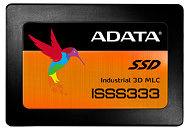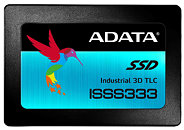- Joined
- Oct 9, 2007
- Messages
- 47,670 (7.43/day)
- Location
- Dublin, Ireland
| System Name | RBMK-1000 |
|---|---|
| Processor | AMD Ryzen 7 5700G |
| Motherboard | Gigabyte B550 AORUS Elite V2 |
| Cooling | DeepCool Gammax L240 V2 |
| Memory | 2x 16GB DDR4-3200 |
| Video Card(s) | Galax RTX 4070 Ti EX |
| Storage | Samsung 990 1TB |
| Display(s) | BenQ 1440p 60 Hz 27-inch |
| Case | Corsair Carbide 100R |
| Audio Device(s) | ASUS SupremeFX S1220A |
| Power Supply | Cooler Master MWE Gold 650W |
| Mouse | ASUS ROG Strix Impact |
| Keyboard | Gamdias Hermes E2 |
| Software | Windows 11 Pro |
ADATA Technology, a leading manufacturer of highperformance DRAM modules and NAND Flash products,today launched industrial-grade ISSS333 solid state drives in 3D MLC and 3D TLC versions. The ISSS333 range offers robust temperature, vibration, and shock tolerance as required in commercial and industrial applications. At the same time, users tap fast performance via universally-compatible SATA 6Gbps in a standard 2.5" form factor. Compared to mechanical storage, ISSS333 drives deliver vastly increased reliability, speed, and power efficiency.
While SSDs become more popular as industrial and commercial storage, demand diversifies. Consequently, ADATA offers the ISSS333 range in 3D MLC and 3D TLC (multi-level cell and triple-level cell) versions. The use of 3D NAND ensures improved reliability and efficiency compared to older 2D NAND, with the MLC models ranging in capacity from 120GB to 1TB while TLC ISSS333 drives ship in 128GB to 1TB.


Hardened industrial-grade design
From the controller to the PCB and materials used in connectors, ISSS333 SSDs are built for harsh environments and rough use. They can handle temperatures from -40 to 90 degrees Celsius (MLC). All models pass 20G vibration resistance and 1500G/0.5ms shock resistance testing, and are designed to work in relative humidity conditions as extreme as 5% to 95%.It also has advanced LDPC ECC (low density parity check error-correcting code) to eliminate the vast majority of potential data errors and ensure the best durability.
High speed, long lifespan, and data integrity
The ISSS333 range maximizes SATA 6Gbps performance. The maximum read/write speed is up to 560/530MB per second. In terms of lifespan, all models boast an MTBF (mean time between failures) rating of 2 million hours. Users also benefit from S.M.A.R.T drive diagnostics, monitoring, and reporting: essential in smooth operations.
View at TechPowerUp Main Site
While SSDs become more popular as industrial and commercial storage, demand diversifies. Consequently, ADATA offers the ISSS333 range in 3D MLC and 3D TLC (multi-level cell and triple-level cell) versions. The use of 3D NAND ensures improved reliability and efficiency compared to older 2D NAND, with the MLC models ranging in capacity from 120GB to 1TB while TLC ISSS333 drives ship in 128GB to 1TB.


Hardened industrial-grade design
From the controller to the PCB and materials used in connectors, ISSS333 SSDs are built for harsh environments and rough use. They can handle temperatures from -40 to 90 degrees Celsius (MLC). All models pass 20G vibration resistance and 1500G/0.5ms shock resistance testing, and are designed to work in relative humidity conditions as extreme as 5% to 95%.It also has advanced LDPC ECC (low density parity check error-correcting code) to eliminate the vast majority of potential data errors and ensure the best durability.
High speed, long lifespan, and data integrity
The ISSS333 range maximizes SATA 6Gbps performance. The maximum read/write speed is up to 560/530MB per second. In terms of lifespan, all models boast an MTBF (mean time between failures) rating of 2 million hours. Users also benefit from S.M.A.R.T drive diagnostics, monitoring, and reporting: essential in smooth operations.
View at TechPowerUp Main Site




